This durian cheesecake recipe is exactly what the name suggests - a cheesecake made with durians. If you are a durian lover, or someone who do not like to eat durian on its own but prefer it made into a dessert, this durian cheesecake recipe is for you.
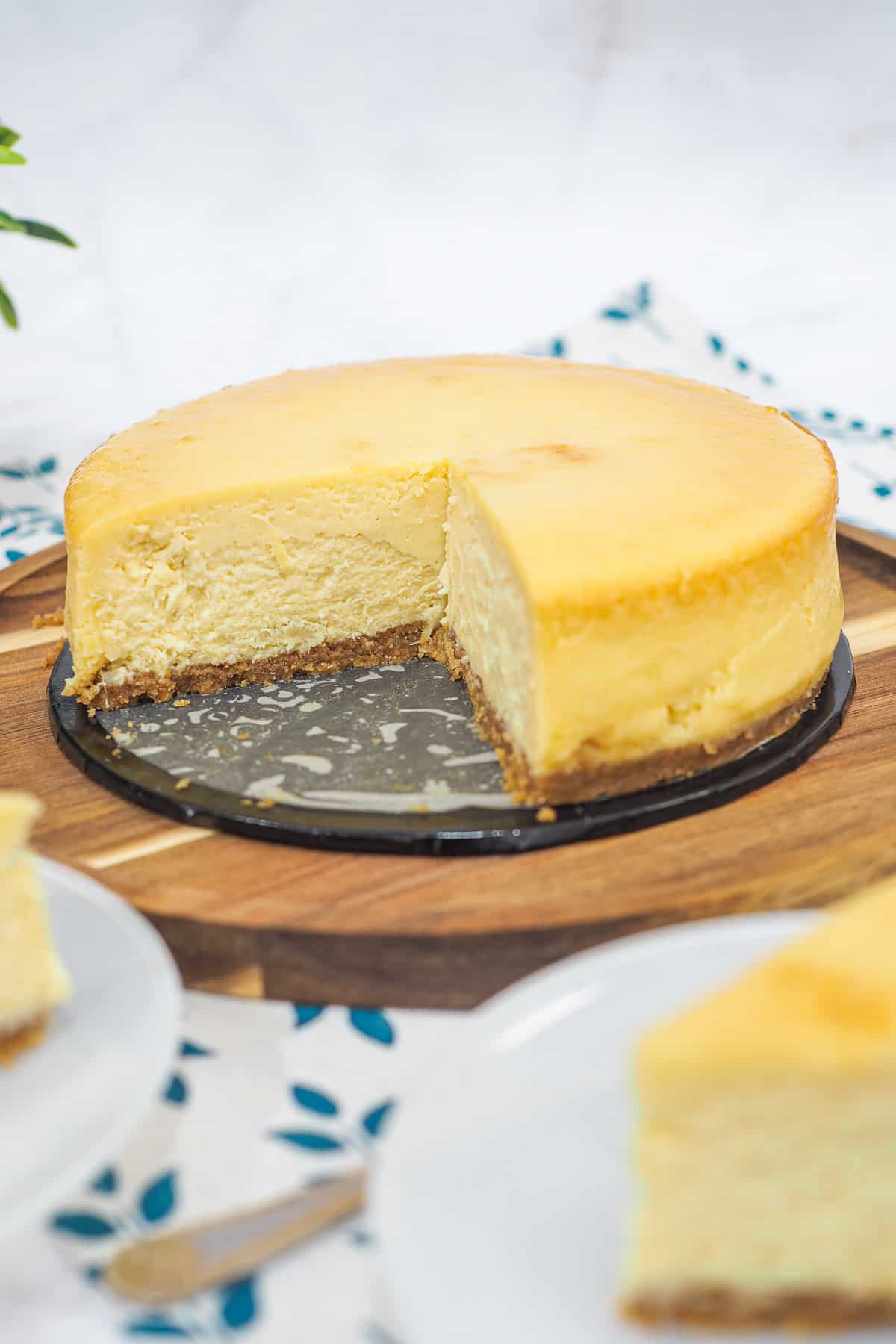
The cheesecake starts with a Digestive cookie crust and is filled with creamy cream cheese and delicious pureed durian filling. Baked in a water bath, the resulting cheesecake is a wonderfully rich and creamy durian flavored cheesecake.
Jump to:
❤️Why you will love this recipe
- This is a baked cheesecake recipe and is filled with a thick and creamy durian flavor packed cream cheese filling on a thin cookie crust. It makes a perfect dessert for durian lovers.
- The recipe is easy and ingredients are fairly simple, except for durian (which is seasonal).
- It is great to be enjoyed as dessert and also as a festive treat (for Eid (Hari Raya) and Chinese New Year.
- The cake is also a great way to use up durian when it is available in abundance during the durian season.
📋Ingredients
Crust
- Digestive cookies (or Graham Crackers) - processed into fine breadcrumbs, this cookies make a lovely crunchy base crust for the cheesecake.
- Granulated sugar (caster sugar) - to sweeten the crust.
- Butter (melted) - I use salted butter. Unsalted butter will also work fine.
Cheesecake Filling
- Cream cheese (at room temperature) - use the block cream cheese and not the spreadable version.
- Granulated sugar (caster sugar) - fine sugar works best as it is more readily dissolved compared to coarse sugar.
- All purpose flour + salt - mix and sift these together to break any lumps in the flour.
- Fresh durian flesh - Remove the flesh and discard the seeds inside. The tastier the durian flesh, the better your cheesecake will taste, so choose good quality and well ripened durian flesh.
- Heavy whipping cream - use dairy cream with at least 35% fat for best results.
- Eggs - use large eggs (large sized)
*Refer to the recipe card below for full list of ingredients and exact quantities. For best results, use a digital kitchen scale where applicable*
🧾Substitution and Variations
- Digestive biscuits can be replaced with others like graham crackers or wafers. For a chocolate option, you can use Oreo cookies. If using cookies with sweet filling like Oreos, you can omit the sugar in the crust.
- Heavy cream can be replaced with sour cream.
- To make a larger durian cake, double the recipe and bake in a 9 inches round springform pan. To make mini durian cheesecakes (like this Earl Grey cheesecakes, mini salted caramel cheesecake, mini Snickers cheesecake and mini Basque cheesecake (burnt cheesecake)), divide the crust and batter into approximately 12 cupcake liners and bake for 20 minutes.
This recipe has not been tested with other substitutions or variations. If you do try, please let me know in the comments section below!
👩🍳How to Make
Preparing the cookie crust
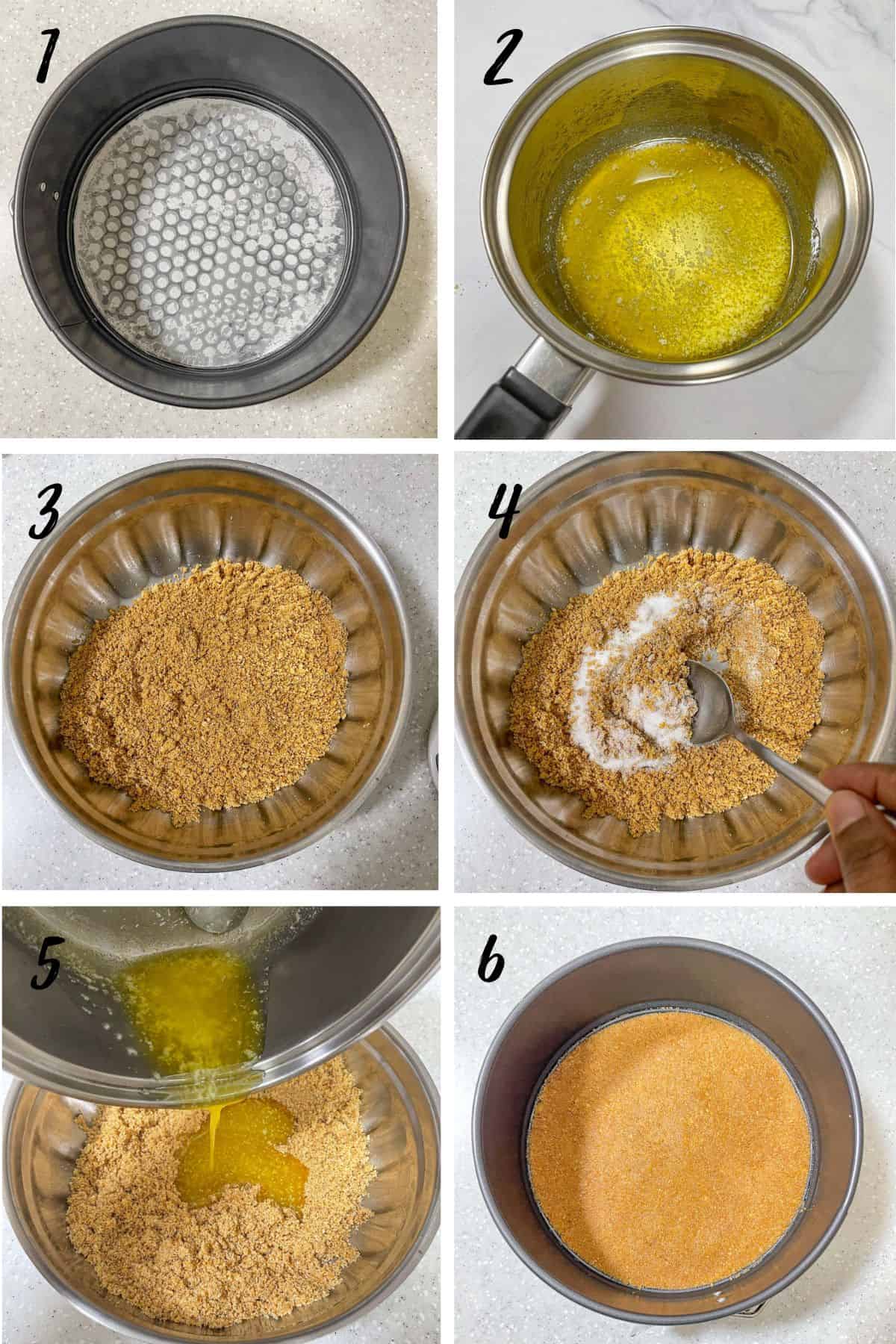
- Prepare a 7 inches round spring form pan. Grease and line the bottom of the pan with parchment paper. This helps in transferring the baked durian cheesecake onto a serving plate after baking and chilling.
- Melt the butter over low heat and set aside to cool down.
- To make the crust, crush the cookies until fine crumbs. You can do this by either placing them in a ziplock bag and using a rolling pin to break them. Or, you can crush the cookies in a food processor until they turn into fine crumbs. Transfer the crumbs into a bowl.
- Add in the sugar. Mix well.
- Next, pour in the melted butter. Mix until the crumbs are thoroughly moistened.
- Transfer the crumbs into your prepared tin. Press them down evenly and firmly with the back of a spoon or the back of a flat drinking glass. Set the crust aside.
Making the filling
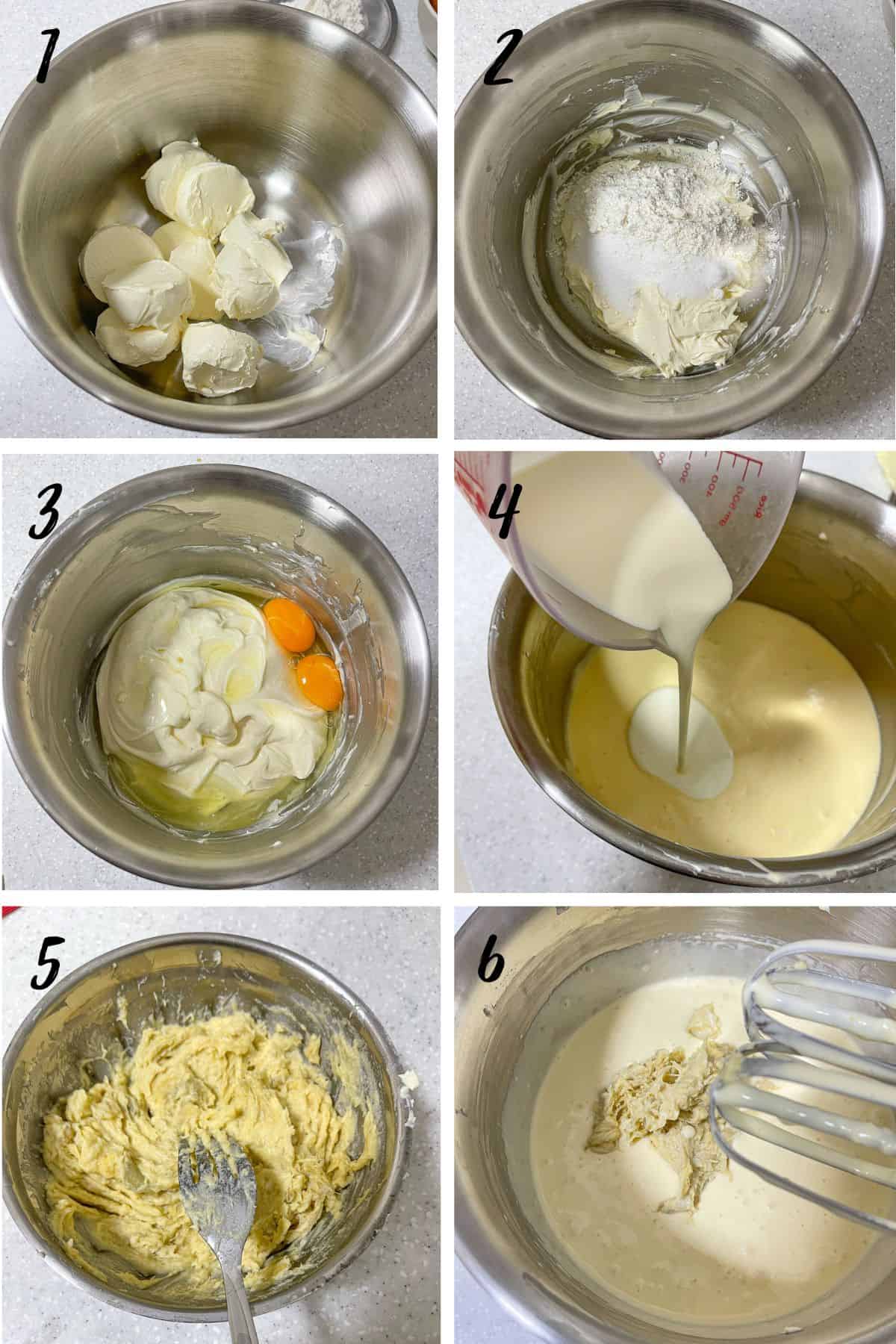
- In a medium-sized mixing bowl, whisk cream cheese on medium to high speed until it turns smooth and creamy, for approximately 30 to 60 seconds. If your cheese is cold, you would need a longer time. If warmer, a short time would be sufficient. The rule of thumb is to not overbeat it, approximately 30 – 60 seconds will do. Scrape the bowl at every 10 seconds interval so there is no cheese stuck to the sides of the bowl.
- Next, add the sugar, flour and salt. Add these all at once. Beat them for approximately 20 seconds until the ingredients are just combined. Scrape the bowl at each 10 seconds interval.
- After that, add both the eggs and beat the mixture for another 10 seconds. Do not overbeat at this stage as that would incorporate too much air in the cheesecake batter, causing it to have a bubbly surface after baking.
- Next, beat in the heavy cream. Mix until it's well combined.
- In a separate bowl, mash the durian flesh until it is becomes creamy. Some durian varieties have considerable amount of fibrous pulp and that is fine. Suffice if the creamy flesh is mashed.
- Add the durian puree into the cheese mixture. Beat for about 20 seconds until it is well incorporated. Pour the cheesecake batter into the prepared crust.
The water bath - 3 methods
- This durian cheesecake, just like all other baked cheesecakes require to be baked in a water bath (or Bain Marie). This simply means placing a bowl or tray of water in the oven as you bake the cheesecake to keep the interior of your oven moist. This in turn will ensure the cheesecake does not have any cracks as it bakes.
- There are a few ways you can achieve the above.
- Firstly, you can wrap the sides of your cake tin in foil and place it in a larger pan filled with water. The foil wrapping will prevent water from seeping into your cheesecake as springform pans have loose bottoms.
- Secondly, you can simply place a bowl of water on the bottom most layer of your own and place your cheesecake on a rack one level above the water. This is the easiest option.
- The third option is to place your springform pan in a slightly larger cake pan and then placing both in another larger pan filled with water. This way, you can avoid water from seeping into your cheesecake and you need not wrap it with foil.
Here is how I did with the third option:
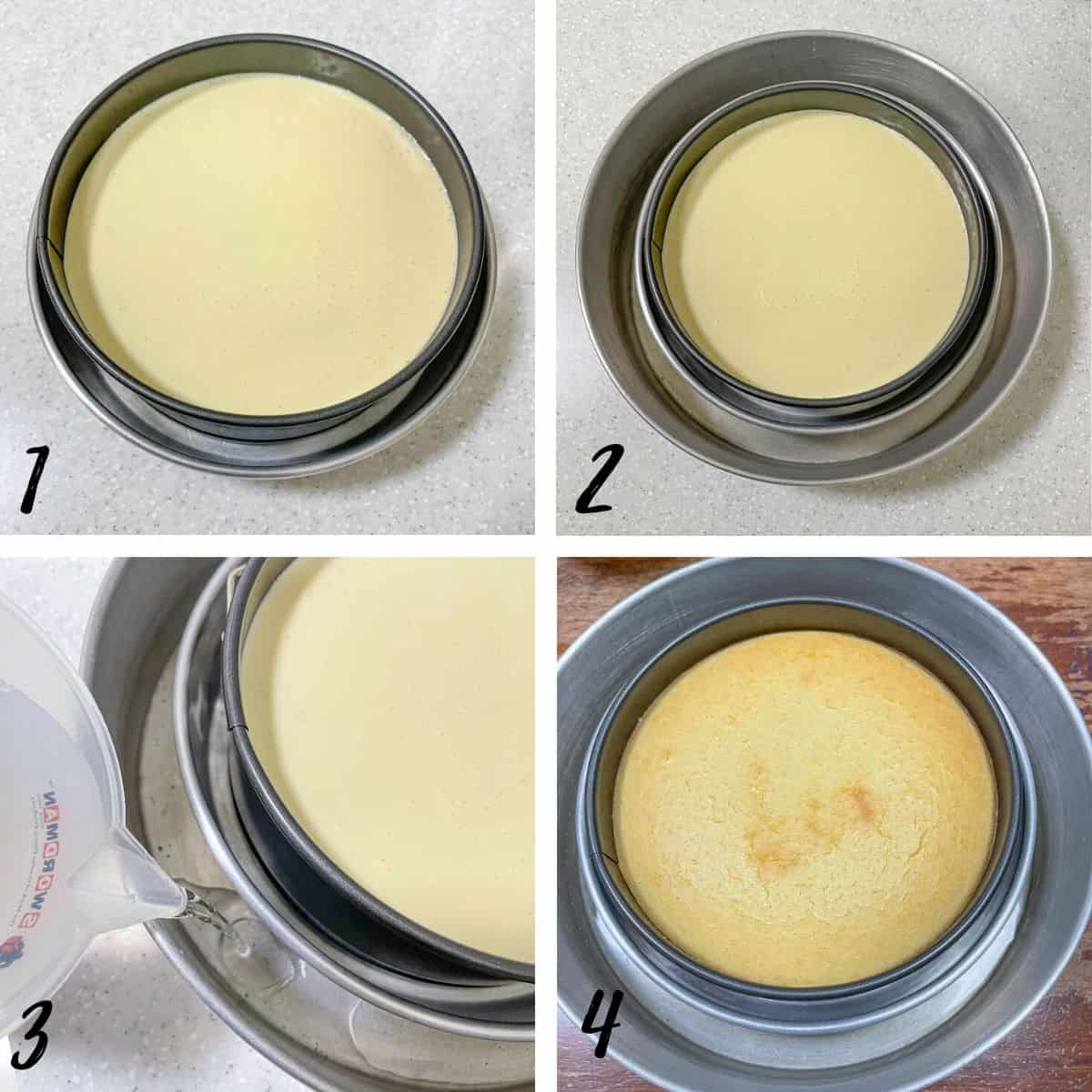
- Place your cake tin in a slightly larger cake tin.
- Place both the tins in another slightly larger cake tin.
- Carefully pour water into the largest cake tin until it is at the halfway mark on the middle tray.
- Gently lift the entire set of cake trays and place them in the oven and bake your cake as indicated in the recipe.
Baking and cooling the cheesecake
- Position the cheesecake in the lowest rack of your oven.
- Bake the cake (with top and bottom heat, but without the fan function) until the sides are firm but the center still wobbly. After baking, turn off the oven and let the cake rest in the oven for about 10 minutes before removing it.
- Once removed, let it rest at room temperature for another 10 to 15 minutes before loosening the sides with a spatula and removing the sides of the cake tin.
- Refrigerate the baked durian cheesecake (along with the bottom of the cake tin) for at least 4 hours (or overnight). It is highly advisable to refrigerate the cake with the bottom of the tin still intact and only remove it once the cake has been thoroughly chilled. This will help ensure the crust does not break as you try to transfer the cake. To transfer the cheesecake into a serving plate, run a jam knife between the parchment lining and the cake tin to loosen it. Use a spatula to help slide the cake (along with the parchment lining) onto the serving plate.
- Keep the durian cheesecake chilled if not serving immediately.
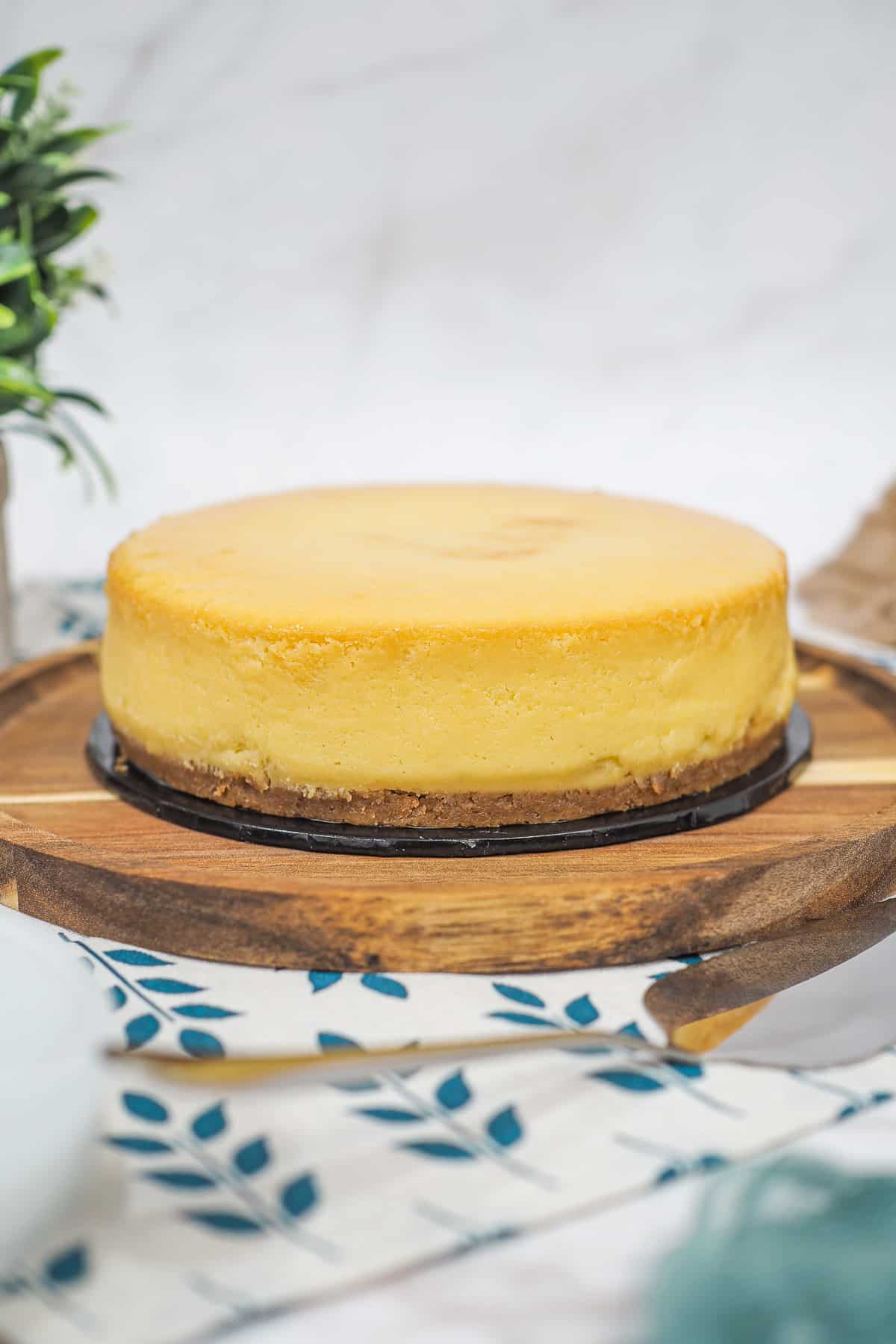
🍽️Serving & storage
- This baked durian cheesecake can last in the fridge for a good 4 to 5 days. Always keep the cheesecake chilled.
💡Expert Tips
Keep the oven temperature low
- Low oven temperature is essential in baking cheesecakes to prevent overbrowning of the cheesecake top. There is also a possibility for the top of the cheesecake to crack due to high temperature.
- A general guide would be to lower your oven temperature by at least 10 degrees Celsius from the temperature used for baking regular cakes.
Do not overmix the cheesecake batter
- Baked cheesecakes, unlike regular cakes (made using the creaming method), should not be whipped or mixed for too long. While sufficient mixing is important for normal cakes to help it incorporate as much as air as possible to help it rise well, it is contrary for cheesecakes.
- Overmixing the durian cheesecake batter will incorporate too much air bubbles into the batter. These air bubbles will cause the top of your cheesecake to have unsightly bubbles on the surface after baking.
- When creaming the cream cheese, make sure it is at room temperature and suffice if the cheese is beaten until it turns creamy. Ideally, this is should be within 60 seconds.
- The sugar and eggs are added separately, and each time, these only require 20 to 30 seconds of beating each.
Position the cake in the lowest rack in your oven and disable the 'fan' setting in the oven.
- This position will help prevent your cheesecake from browning too much at the top. It would also help prevent cracks in your cheesecake.
- If your oven comes with a fan function, disable the fan function. This helps in avoiding the top of your durian cheesecake from over-browning as well as avoid any cracks.
Avoid overbaking cheesecakes
- Overbaking can result in the texture of the baked cheesecakes to be leathery and eggy. It can also cause cracks in the cheesecakes.
- Ideally, cheesecakes should only be baked until the sides are set but the center still wobbly. The cakes will continue to cook as they cool down in the oven after baking (turn off the oven and leave the cakes in the oven for 10 minutes after baking).
- Letting the cakes rest in the oven after baking helps them to cool down gradually. This gradual cooling down process also helps avoid cracks in cheesecakes due to sudden temperature changes.
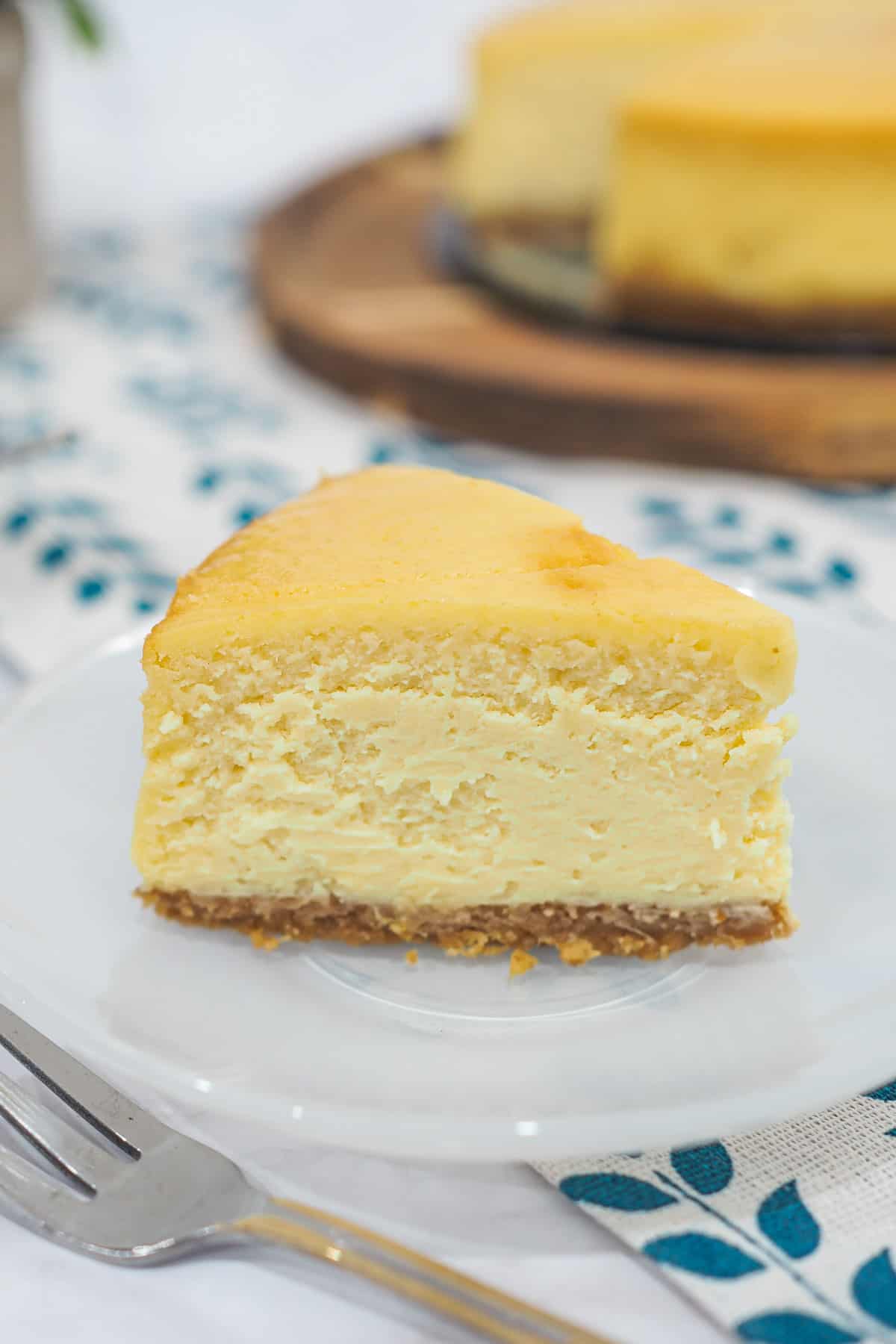
💭FAQs
Durian is a seasonal tropical fruit found in the Southeast Asia regions of Malaysia, Indonesia, Thailand, Singapore and a few other countries. The fruit is also known as king of fruits and has pointy thorns all over its skin. It grows on tall trees and is green in color. Most fruits are round in shape and are also the size of watermelons although there are also those which are irregularly shaped.
The fruit is made up of individual segments and within each segment, there are about 2 to 4 pieces of durian flesh. Each piece has a brown seed in the core. The skin and seeds are discarded and it is the creamy custard-like flesh that is consumed.
Durian is a very controversial fruit. There are some people who totally love the fruit and are willing to pay a high price for a good variety, while some others totally despise it. This is due to its pungent smell which is totally off putting for some.
There are many varieties of durians and the price of durian vary quite substantially between each variety. Musang King durian is a famous variant in Malaysia and hard core durian lovers often times are willing to pay the high price for the high-end varieties.
So if you are one of the durian lovers, this durian cheesecake is another good way to enjoy the fruit besides eating it on its own.
Heat is often associated with cracked cheesecakes. If the cheesecake is baked in a very hot oven, it has a tendency to crack. Overbaking is also a contributing factor. Always keep to the temperature and baking time as indicated in the recipe.
Baked cheesecakes will turn eggy or rubbery if overbaked. Always keep to the time indicated in the recipe. Cheesecakes should typically bake to the point the edges become firm but the center still wobbly. This is because the cake will continue to cook even after you turn off the oven, hence it is advisable to stop the baking once the sides have firmed up.
❤️More Recipes You Will Love
Do you like this recipe? Please leave a 5-star ⭐⭐⭐⭐⭐rating in the recipe card below and consider a review further down this page. I would love to hear from you. Thank you!
📖Recipe
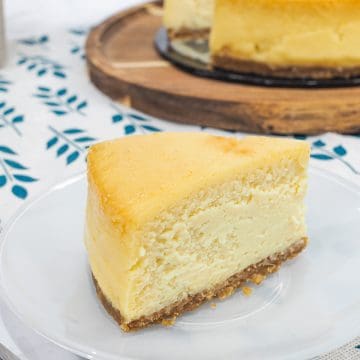
Durian Cheesecake (Perfectly Creamy & Simply the Best!)
For best results, use the metrics measurements. US customary measurements have not been tested and are only meant for guide.
Ingredients
Crust
- 100 g Digestive cookies or Graham Crackers
- 50 g butter melted
- 15 g granulated sugar
Cream Cheese Filling
- 400 g cream cheese at room temperature
- 125 g granulated sugar
- 150 g durian flesh
- 20 g all purpose flour
- 2 eggs
- 120 g heavy cream
- ⅛ teaspoon salt
Instructions
- Preheat oven to 160°Celsius.
Making the crust
- Crush the Digestive cookies into crumbs by processing them in a food processor or by putting them in a zip lock bag and pressing them with a rolling pin.
- Place the crumbs in a bowl. Add the sugar. Mix well.
- Melt butter. Let it cool down before adding to the crumbs. Mix well.
- Transfer the crust mix into a parchment paper-lined 7 inches round springform pan and press it down evenly and firmly. Set aside.
Making the cheesecake filling
- In a separate bowl, beat cream cheese until smooth for 30 - 60 seconds.
- Scrape the sides of the bowl, add the sugar, flour, and salt. Beat again for 20 seconds.
- Add in both the eggs. Beat for about 10 seconds until the eggs are well combined. Scrape the bowl and continue beating for another 10 seconds until the batter is all smooth and creamy. Do not overbeat to avoid the batter from incorporating too much air.
- Next, pour in the heavy cream and beat again until it is well incorporated into the batter, for approximately 20 seconds.
- In a separate bowl, mash the durian flesh until it is becomes creamy. Some durian varieties have considerable amount of fibrous pulp and that is fine. Suffice if the creamy flesh is mashed.
- Add the durian flesh into the cheesecake batter. Beat for about 20 seconds until it is well incorporated.
Baking the durian cheesecake
- Pour the batter into the prepared crust and bake in a water bath for 60 minutes at 160 °Celsius. When done, the sides should be firm and the center of the cake still wobbly. Turn the oven off and leave the cake in the oven for another 10 minutes.
- Remove from oven and let the cake cool for another 20 minutes before loosening the cake tin and removing the cake out.
- Let the cake rest in the refrigerator for at least 4 hours or overnight before serving.
- Keep leftovers refrigerated.
Notes
Keep the oven temperature low
- Low oven temperature is essential in baking cheesecakes to prevent overbrowning of the cheesecake top. There is also a possibility for the top of the cheesecake to crack due to high temperature.
- A general guide would be to lower your oven temperature by at least 10 degrees Celsius from the temperature used for baking normal cakes.
Do not overmix the cheesecake batter
- Baked cheesecakes, unlike normal cakes (made using the creaming method), should not be whipped or mixed for too long. While sufficient mixing is important for normal cakes to help it incorporate as much as air as possible to help it rise well, it is contrary for cheesecakes.
- Overmixing the durian cheesecake batter will incorporate too much air bubbles into the batter. These air bubbles will cause the top of your cheesecake to have unsightly bubbles on the surface after baking.
- When creaming the cream cheese, make sure it is at room temperature and suffice if the cheese is beaten until it turns creamy. Ideally, this is should be within 60 seconds.
- The sugar and eggs are added separately, and each time, these only require 20 to 30 seconds of beating each.
Position the cake in the lowest rack in your oven and disable the 'fan' setting in the oven.
- This position will help prevent your cheesecake from browning too much at the top. It would also help prevent cracks in your cheesecake.
- If your oven comes with a fan function, disable the fan function. This helps in avoiding the top of your durian cheesecake from over-browning as well as avoid any cracks.
Avoid overbaking cheesecakes
- Overbaking can result in the texture of the baked cheesecakes to be leathery and eggy. It can also cause cracks in the cheesecakes.
- Ideally, cheesecakes should only be baked until the sides are set but the center still wobbly. The cakes will continue to cook as they cool down in the oven after baking (turn off the oven and leave the cakes in the oven for 10 minutes after baking).
- Letting the cakes rest in the oven after baking helps them to cool down gradually. This gradual cooling down process also helps avoid cracks in cheesecakes due to sudden temperature changes.


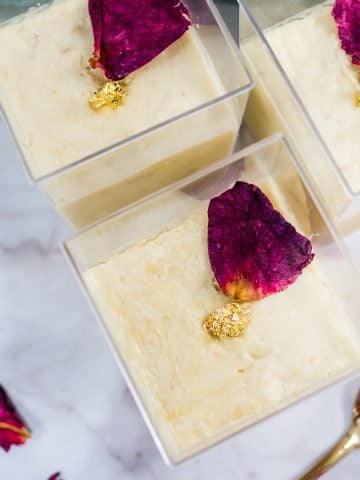
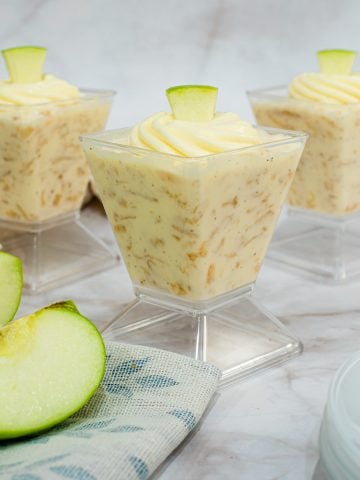
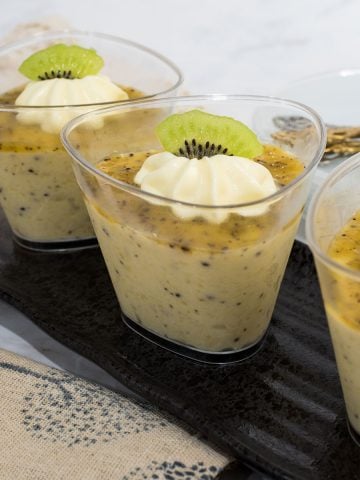
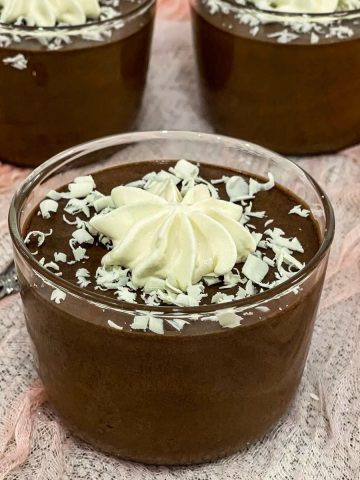

Leave a Reply